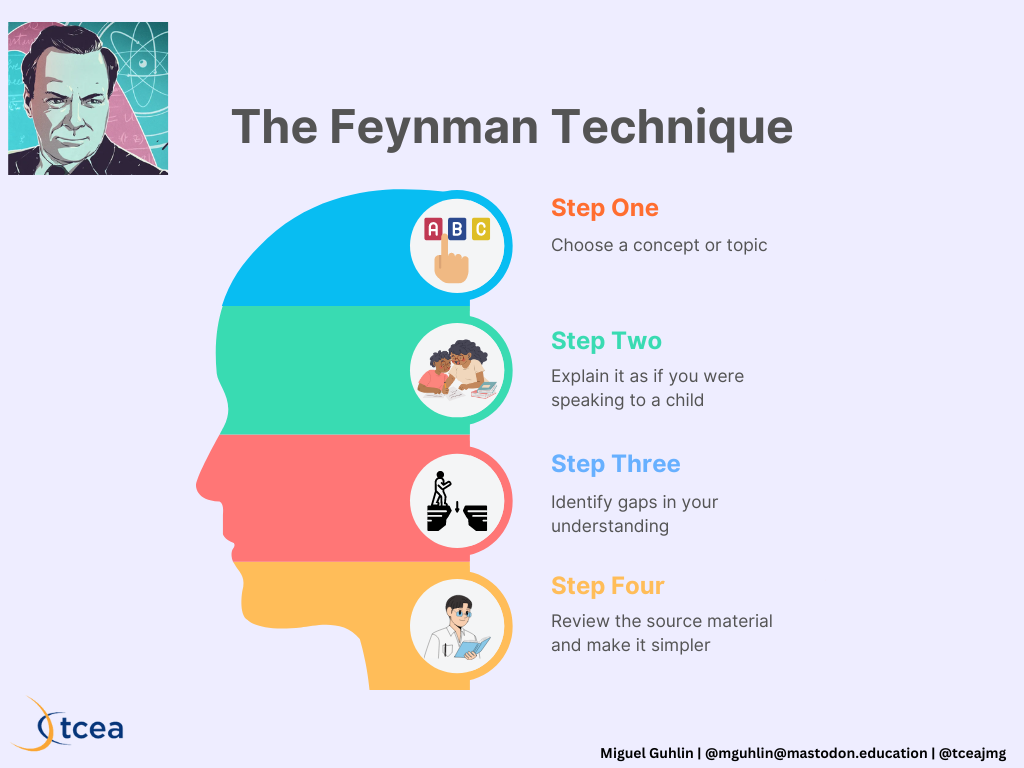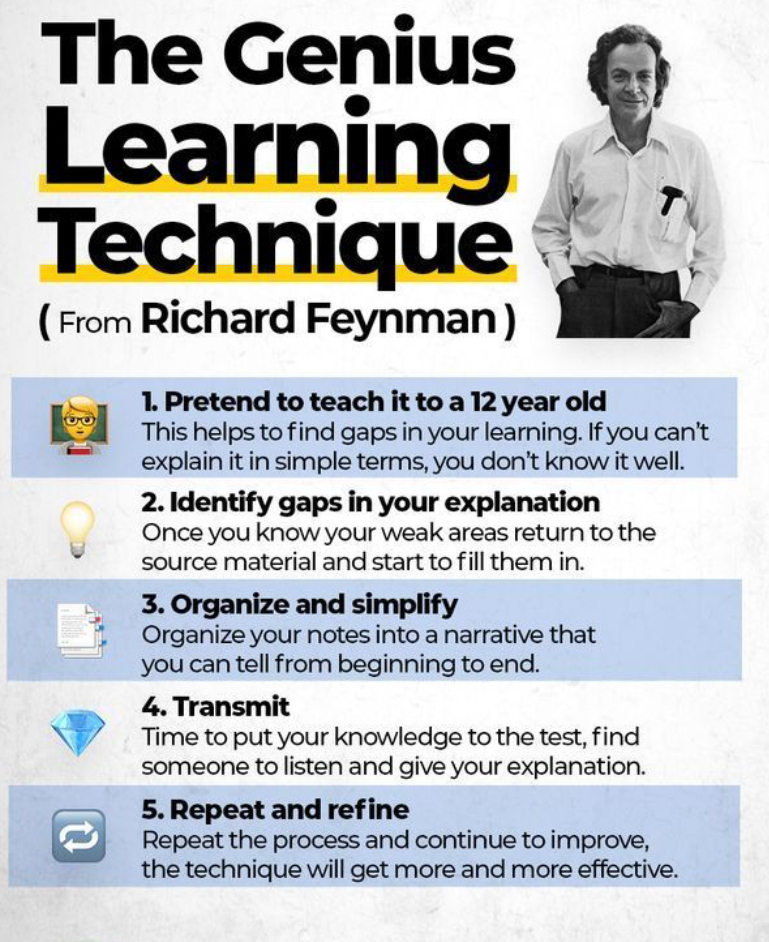Exploring the Feynman Technique #tceajmg #tcea

At the Elementary Technology Conference later today, I’ll be facilitating a session on Digital and Evidence-Based Strategies to Enhance PreK-5 Literacy. One of my slides in the over 80 for a 3 hour session, funny enough, is The Feynman Technique. It’s an approach I’ve fallen into by accident during my long years of professional development and teaching, but it’s not one I have followed knowingly or strictly.
It’s worth taking the time to learn it better, and I’ve been reviewing it for future use.
Learn More About It
Here is a short list of resource links explaining The Feynman Technique:
| Title | URL |
|---|---|
| Feynman Technique: FAQs & Explanation | InnovationTraining.org |
| The Feynman Technique: Master the Art of Learning | Farnam Street |
| The Feynman Technique: Study Skills' Secret Weapon | Oxford Learning |
| How I Used the Feynman Technique to Study and Got Better Grades | Study.com |
| The Feynman Technique | Ali Abdaal |
An AI-Generated Example
The Feynman Technique is a powerful method for learning and understanding complex concepts by breaking them down into simpler terms. Here, we’ll use the Feynman Technique to explain the use of Perplexity AI.
Step 1: Choose a Concept
Concept: Perplexity AI
Step 2: Explain the Concept in Simple Terms
Perplexity AI is an AI-powered search engine that helps you find information quickly and accurately. Unlike traditional search engines like Google, which provide a list of links, Perplexity AI gives you direct answers to your questions, along with citations from various sources. It uses advanced language models to understand your queries and provide detailed, relevant responses.
Step 3: Identify Gaps in Your Understanding
To ensure a thorough understanding, let’s break down the key features and uses of Perplexity AI:
- Search Capabilities: Perplexity AI can search the web in real-time and provide concise answers, making it easier to find information without sifting through multiple links.
- Language Models: It uses multiple large language models (LLMs) like GPT-4, Claude, and Gemini to understand and respond to queries.
- Multimodal Capabilities: Perplexity AI can handle text, images, and documents, making it versatile for various types of queries.
- Pro Search: This feature allows for more detailed and personalized searches, asking follow-up questions to refine the results.
- Collections and Threads: Users can organize their searches into collections and threads, making it easier to manage and revisit information.
Step 4: Simplify and Use Analogies
Simplified Explanation: Imagine you have a very smart assistant who can answer any question you have. Instead of giving you a list of books or articles to read, this assistant reads them for you and tells you exactly what you need to know. This assistant can also understand different types of questions, whether they are about text, pictures, or documents. If you ask a complicated question, the assistant will ask you more questions to make sure it gives you the best answer. You can also keep all the answers organized in a notebook that you can look at anytime.
Final Explanation
Perplexity AI is like having a super-smart assistant that helps you find answers quickly and accurately. It uses advanced technology to understand your questions and gives you direct answers, saving you time and effort. You can ask it about anything, and it will search the web, read the information, and tell you what you need to know. Plus, you can keep all your questions and answers organized in one place for easy access later.
By using the Feynman Technique, we’ve broken down the concept of Perplexity AI into simple, understandable terms, ensuring a deeper understanding of its features and uses.
Prompt Generation
Love this example:
ChatGPT + the Feynman Technique to learn anything via Ruben Hassid:

Copy & paste this prompt from rubenhassid.ai
“Act like an expert educator and mentor.
You have been helping students and professionals master complex topics using the Feynman Technique for over 20 years.
You specialize in breaking down intricate subjects into understandable, manageable pieces through iterative learning and teaching.
Objective:
I want to master any topic using the Feynman Technique by following a structured, multi-step process. The goal is to achieve deep understanding through multiple iterations and refinements.
Step-by-Step Process:
Topic Selection and Initial Explanation:
Identify the topic I want to master.
Write a clear, simple explanation of the topic as if teaching it to someone with no prior knowledge. Ensure the explanation is thorough but understandable. Identify Gaps in Understanding:
Review the initial explanation and identify any areas where my understanding is lacking or unclear.
Highlight specific concepts, terms, or sections that need further clarification or research.
Deep Dive into Problem Areas:
Conduct research to fill in the gaps identified. Use reliable sources such as academic papers, textbooks, and expert opinions.
Rewrite the initial explanation, incorporating the new knowledge gained from this research. Ensure the explanation remains clear and straightforward. Simplify and Clarify:
Simplify the refined explanation further. Use analogies, metaphors, and examples to make complex ideas more accessible.
Ensure that the explanation can be understood by someone with no background in the topic.
Teach and Test:
Teach the topic to a friend, family member, or imaginary student. Pay attention to any questions they might have and areas where they seem confused.
Use their feedback to identify any remaining gaps or unclear sections in your explanation.
Iterate and Refine:
Iterate on the explanation based on the feedback received. Continue to simplify and clarify until the explanation is seamless and easily understandable.
Repeat the teaching and feedback process as many times as necessary to achieve a deep and thorough understanding of the topic.
Final Review and Reflection:
Review the final explanation and reflect on the learning process. Summarize the key insights and understandings gained.
Consider how the Feynman Technique helped in mastering the topic and any improvements or adjustments that can be made for future learning endeavors.
Start with “What is the topic you’d like to master?” to know what I want to master. You can’t move on without this step.
Take a deep breath and work on this problem step-by-step.”
This is one of my 53 prompts from my library.
3,346 people have access to it. Forever.
Get your own at rubenhassid.ai
♻️ Repost this image if you learned something.
Image from the one & only Colby Kultgen.